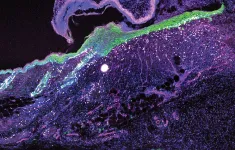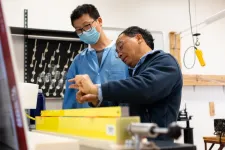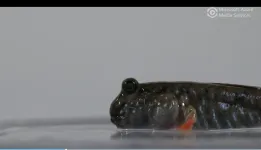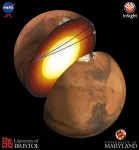(Press-News.org) It’s a dangerous world out there. From bacteria and viruses to accidents and injuries, threats surround us all the time. And nothing protects us more steadfastly than our skin. The barrier between inside and out, the body’s largest organ is also its most seamless defense.
And yet the skin is not invincible. It suffers daily the slings and arrows of outrageous fortune, and it tries to keep us safe by sensing and responding to these harms. A primary method is the detection of a pathogen, which kicks the immune system into action. But new research from the lab of Rockefeller’s Elaine Fuchs, published in Cell, reveals an alternative protective mechanism that responds to injury signals in wounded tissue—including low oxygen levels from blood vessel disruption and scab formation—and it doesn’t need an infection to get into gear.
The study is the first to identify a damage response pathway that is distinct from but parallel to the classical pathway triggered by pathogens.
At the helm of the response is interleukin-24 (IL24), whose gene is induced in skin epithelial stem cells at the wound edge. Once unleashed, this secreted protein begins to marshal a variety of different cells to begin the complex process of healing.
“IL24 is predominately made by the wound-edge epidermal stem cells, but many cells of the skin—the epithelial cells, the fibroblasts, and the endothelial cells—express the IL24 receptor and respond to the signal. IL24 becomes an orchestrator that coordinates tissue repair,” says Fuchs, head of the Robin Chemers Neustein Laboratory of Mammalian Cell Biology and Development.
Hints from pathogen-induced signaling
Scientists have long understood how the host responses protect our body from pathogen-induced threats: somatic cells recognize invading bacteria or viruses as foreign entities and induce a number of defense mechanisms with the help of signaling proteins such as type 1 interferons.
But how does the body respond to an injury that may or may not involve foreign invader? If we cut a finger while slicing a cucumber, for example, we know it instantly—there’s blood and pain. And yet how the detection of injury leads to healing is poorly understood on a molecular basis.
While type 1 interferons rely on the signaling factors STAT1 and STAT2 to regulate the defense against pathogens, previous research by the Fuchs lab had shown that a similar transcription factor known as STAT3 makes its appearance during wound repair. Siqi Liu, co-first author in both studies, wanted to trace STAT3’s pathway back to its origin.
IL24 stood out as a major upstream cytokine that induces STAT3 activation in the wounds.
Microbe-independent action
In collaboration with Daniel Mucida’s lab at Rockefeller, the researchers worked with mice under germ-free conditions and found that the wound-induced IL24 signaling cascade is independent of germs.
But what injury signals induced the cascade? Wounds often extend into the skin dermis, where capillaries and blood vessels are located.
“We learned that the epidermal stem cells sense the hypoxic environment of the wound,” says Yun Ha Hur, a research fellow in the lab and a co-first author on the paper.
When the blood vessels are severed and a scab forms, epidermal stem cells at the edge of the wound are starved of oxygen. This state of hypoxia is an alarm bell for cell health, and induced a positive feedback loop involving transcription factors HIF1a and STAT3 to amplify IL24 production at the wound edge. The result was a coordinated effort by a variety of cell types expressing the IL24 receptor to repair the wound by replacing damaged epithelial cells, healing broken capillaries, and generating fibroblasts for new skin cells.
Collaborating with Craig Thompson’s group at Memorial Sloan Kettering Cancer Center, the researchers showed that they could regulate Il24 gene expression by changing oxygen levels.
Once the researchers pinpointed the origin of the tissue-repair pathway in epidermal stem cells, they studied the wound repair process in mice that had been genetically modified to lack IL24 functionality. Without this key protein, the healing process was sluggish and delayed, taking days longer than in normal mice to completely restore the skin.
They speculate that IL24 might be involved in the injury response in other body organs featuring epithelial layers, which act as a protective sheath. In recent studies, elevated IL24 activity has been spotted in epithelial lung tissue of patients with severe COVID-19 and in colonic tissue in patients with ulcerative colitis, a chronic inflammatory bowel disease.
“IL24 could be working as a cue to signal the need for injury repair in many organs,” Hur says.
Linked by function and evolution
“Our findings provide insights into an important tissue damage sensing and repair signaling pathway that is independent of infections,” explains Fuchs.
An analysis with evolutionary biologist Qian Cong at UT Southwestern Medical Center revealed that IL24 and its receptors share close sequence and structure homology with the interferon family. Though they may not always be working in coordination at every moment, IL24 and interferons are evolutionarily related and bind to receptors sitting near each other on the surface of cells. The researchers suspect that these signaling molecules derive from a common molecular pathway dating far back in our past.
“We think that hundreds of millions of years ago, this ancestor might have diverged into two pathways—one being pathogen defense and the other being tissue injury,” Liu says.
Perhaps the split occurred to cope with an explosion of pathogens and injuries that caused a sea of troubles for life on Earth.
END
Researchers reveal an ancient mechanism for wound repair
2023-04-24
ELSE PRESS RELEASES FROM THIS DATE:
Using superconductors to move people, cargo and energy through one combined system
2023-04-24
The promise of superconductivity for electrical power transmission and transportation has long been held back by high costs. Now researchers from the University of Houston and Germany have demonstrated a way to cut the cost and upend both the transit and energy transport sectors by using superconductors to move people, cargo and energy along existing highway infrastructure.
The combined system would not only lower the cost of operating each system but would also provide a way to store and transport liquified hydrogen, an important ...
Brian Clark selected to speak, presented discoveries at NIH workshop and in Journal of Gerontology
2023-04-24
Ohio University Professor of Physiology and Executive Director of the Ohio Musculoskeletal and Neurological Institute (OMNI) Brian Clark Ph.D. was one of 40 expert leaders in the field of aging from around the world chosen to present at a workshop hosted by the National Institute of Health’s (NIH) National Institute on Aging (NIA) on the development of function promoting therapies for age-related weakness. Clark was also asked by the NIH to publish a comprehensive review of his research over the past decade in the Journal of Gerontology.
The workshop covered ...
Increased risk of Alzheimer's disease due to exposure to polycyclic aromatic hydrocarbons
2023-04-24
Polycyclic aromatic hydrocarbons (PAHs) are typical organic compounds found in cigarette smoke and vehicle exhaust. In addition, PAHs are produced from incomplete combustion of organic material and cooking. The highest concentrations of PM-bound PAHs ranged from 550 ng/m3 to 39000 ng/m3, were observed in Chinese kitchens, fire stations, and ships. Polycyclic aromatic hydrocarbons may combine with ultrafine particles (UFPs) in the air to form particle-bound PAHs. PM0.1 may adsorb large amounts of toxic organic compounds, and long-term exposure to indoor UFPs from cooking resulted in ...
This gel stops brain tumors in mice. Could it offer hope for humans?
2023-04-24
Medication delivered by a novel gel cured 100% of mice with an aggressive brain cancer, a striking result that offers new hope for patients diagnosed with glioblastoma, one of the deadliest and most common brain tumors in humans.
“Despite recent technological advancements, there is a dire need for new treatment strategies,” said Honggang Cui, a Johns Hopkins University chemical and biomolecular engineer who led the research. “We think this hydrogel will be the future and will supplement current treatments for brain cancer.”
Cui’s team combined an anticancer drug and ...
New tools capture economic benefit of restoring urban streams
2023-04-24
An interdisciplinary team of researchers has developed a suite of tools to estimate the total economic value of improving water quality in urban streams. The work can assist federal and state agencies charged with developing environmental regulations affecting urban ecosystems across the Piedmont Region of the United States, which stretches from Maryland to Alabama.
“Urban streams are ubiquitous and face a number of stressors from rapid economic development,” says Roger von Haefen, professor of agricultural and resource economics at North Carolina State University and corresponding ...
A blinking fish reveals clues as to how our ancestors evolved from water to land
2023-04-24
UNIVERSITY PARK, Pa. — An unusual blinking fish, the mudskipper, spends much of the day out of the water and is providing clues as to how and why blinking might have evolved during the transition to life on land in our own ancestors. New research shows that these amphibious fish have evolved a blinking behavior that serves many of the same purposes of our blinking. The results suggest that blinking may be among the suite of traits that evolved to allow the transition to life on land in tetrapods — the group of animals that includes mammals, birds, reptiles and amphibians — some 375 million years ago.
The study appears the week ...
New machine-learning method predicts body clock timing to improve sleep and health decisions
2023-04-24
A new machine-learning method could help us gauge the time of our internal body clock, helping us all make better health decisions, including when and how long to sleep.
The research, which has been conducted by the University of Surrey and the University of Groningen, used a machine learning programme to analyse metabolites in blood to predict the time of our internal circadian timing system.
To date the standard method to determine the timing of the circadian system is to measure the timing of our ...
Health surveys, studies exclude trans people and gender-diverse communities, impacting health care
2023-04-24
ANN ARBOR—Health surveys and clinical studies have a data collection problem: Because of the way they record sex or gender, they often exclude transgender and gender-diverse people, according to University of Michigan research.
Most studies and surveys either ask participants for their sex, a biological construct, or their gender, a social construct. In this way, they only consider either sex or gender independently or use the two concepts interchangeably, says Kate Duchowny, a research assistant professor in the Survey Research Center at the U-M Institute for Social Research.
Participants either respond with their sex assigned at birth or the ...
Scientists detect seismic waves traveling through Martian core for the first time
2023-04-24
Scientists observed seismic waves traveling through Mars’ core for the first time and confirmed model predictions of the core’s composition.
An international research team—which included University of Maryland seismologists—used seismic data acquired by the NASA InSight lander to directly measure properties of Mars’s core, finding a completely liquid iron-alloy core with high percentages of sulfur and oxygen. Published in the Proceedings of the National Academy of Sciences on April 24, 2023, these findings reveal new insights into how Mars formed and geological differences ...
Pioneering research sheds new light on the origins and composition of planet Mars
2023-04-24
A new study has uncovered intriguing insights into the liquid core at the centre of Mars, furthering understanding of the planet’s formation and evolution.
The research, led by the University of Bristol and published in the journal Proceedings of the National Academy of Sciences of the US, reveals the first-ever detections of sound waves travelling into the Martian core. Measurements from this acoustic energy, called seismic waves, indicate its liquid core is slightly denser and smaller than previously thought, and comprises a mixture of iron and numerous other elements.
The ...






